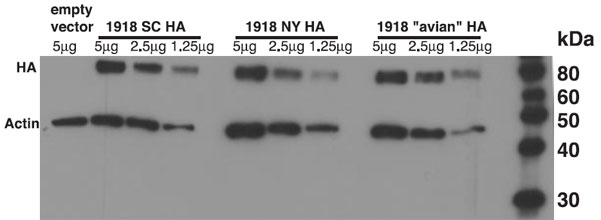Anti-Influenza A (H1N1) 1918, H1 Hemagglutinin (HA) [39E4] Antibody
This mouse IgG2a monoclonal antibody [39E4] was generated against inactivated virus and specific for H1 hemagglutinin (HA) of influenza virus A/South Carolina/1/1918 (H1N1).
Highlights
- Reacts with H1 hemagglutinin (HA) of influenza virus A/South Carolina/1/1918 (H1N1)
- Suitable for ELISA, Hemagglutination Inhibition Assays, Neutralization and Western Blot applications
Influenza A (H1N1) virus is the subtype of influenza A virus that was the most common cause of human influenza (flu) outbreaks in 2009 as well as 1918. H1N1 is an orthomyxovirus because it contains the glycoproteins haemagglutinin and neuraminidase. Haemagglutinin causes red blood cells to clump together and binds the virus to the infected cell. In Neuraminidase are a type of glycoside hydrolase enzyme which help to move the virus particles through the infected cell and assist in budding from the host cells.
From the laboratories of Peter Palese, PhD, Adolfo Garcia-Sastre, PhD, Christopher F. Basler, PhD, Thomas M. Moran, PhD, Icahn School of Medicine at Mount Sinai.
This mouse IgG2a monoclonal antibody [39E4] was generated against inactivated virus and specific for H1 hemagglutinin (HA) of influenza virus A/South Carolina/1/1918 (H1N1).
Highlights
- Reacts with H1 hemagglutinin (HA) of influenza virus A/South Carolina/1/1918 (H1N1)
- Suitable for ELISA, Hemagglutination Inhibition Assays, Neutralization and Western Blot applications
Influenza A (H1N1) virus is the subtype of influenza A virus that was the most common cause of human influenza (flu) outbreaks in 2009 as well as 1918. H1N1 is an orthomyxovirus because it contains the glycoproteins haemagglutinin and neuraminidase. Haemagglutinin causes red blood cells to clump together and binds the virus to the infected cell. In Neuraminidase are a type of glycoside hydrolase enzyme which help to move the virus particles through the infected cell and assist in budding from the host cells.
From the laboratories of Peter Palese, PhD, Adolfo Garcia-Sastre, PhD, Christopher F. Basler, PhD, Thomas M. Moran, PhD, Icahn School of Medicine at Mount Sinai.
| Product Type: | Antibody |
| Name: | 1918 Influenza HA |
| Accession ID: | P03454 |
| Isotype: | IgG2a |
| Clonality: | Monoclonal |
| Clone Name: | 39 E4 |
| Reactivity: | Virus |
| Immunogen: | Inactivated virus |
| Species Immunized: | Mouse |
| Purification Method: | Protein G |
| Buffer: | PBS, 0.05% (w/v) Sodium Azide |
| Tested Applications: | ELISA, neutralization |
| Storage: | -20C |
| Shipped: | Cold packs |
Western Blot

293T cells transfected with 3 ?g pCAGGS 1918 HA constructs. The blot was probed with an anti-1918 HA monoclonal antibody (39E4) and an anti-actin monoclonal antibody. Total cellular protein of 5 ?g, 2.5 ?g, or 1.25 ?g was loaded as indicated.
Adapted from: Glaser L. et al. J Virol. 2005 Sep;79(17):11533-6.
- Manicassamy B, Medina RA, Hai R, Tsibane T, Stertz S, Nistal-Villán E, Palese P, Basler CF, García-Sastre A. Protection of mice against lethal challenge with 2009 H1N1 influenza A virus by 1918-like and classical swine H1N1 based vaccines. PLoS Pathog. 2010 Jan 29;6(1):e1000745.
- Tumpey TM, García-Sastre A, Mikulasova A, Taubenberger JK, Swayne DE, Palese P, Basler CF. Existing antivirals are effective against influenza viruses with genes from the 1918 pandemic virus. Proc Natl Acad Sci U S A. 2002 Oct 15;99(21):13849-54.
- Glaser L, Stevens J, Zamarin D, Wilson IA, García-Sastre A, Tumpey TM, Basler CF, Taubenberger JK, Palese P. A single amino acid substitution in 1918 influenza virus hemagglutinin changes receptor binding specificity. J Virol. 2005 Sep;79(17):11533-6.
If you publish research with this product, please let us know so we can cite your paper.

![Anti-Influenza A (H1N1) 1918, H1 Hemagglutinin (HA) [39E4] Antibody Anti-Influenza A (H1N1) 1918, H1 Hemagglutinin (HA) [39E4] Antibody](https://www.kerafast.com/MediaStorage/Product/Images/Medium/1127_2001202001263511260.jpg)
